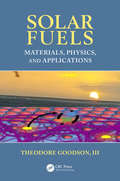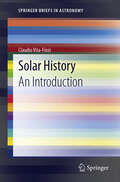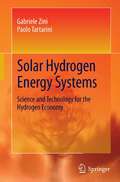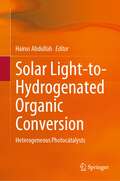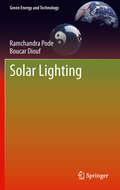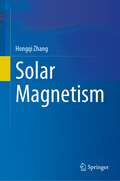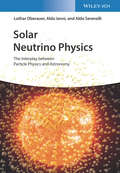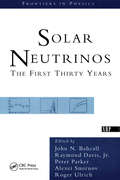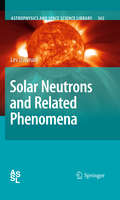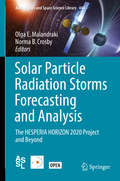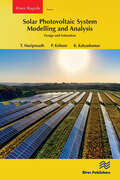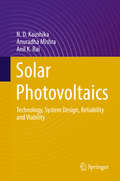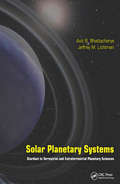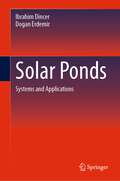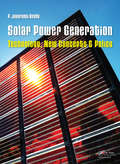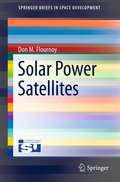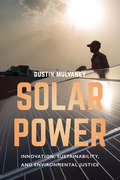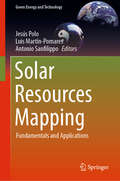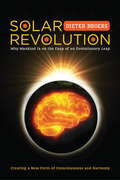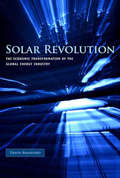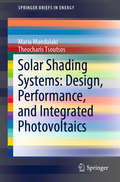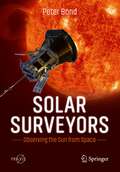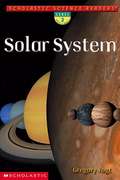- Table View
- List View
Solar Fuels: Materials, Physics, and Applications
by Iii Theodore GoodsonWritten for use as a text and reference for those interested in how new materials may be used to capture, store, and use solar energy for alternative energy resources in everyday life, Solar Fuels: Materials, Physics, and Applications discusses the fundamentals of new materials and the physical processes involved in their mechanisms and design. This book offers clear examples of current state-of-the-art organic and inorganic solar cell materials and devices used in the field, and includes experiments testing solar capability along with standardized examples. Last, but not least, it also gives a clear outline of the challenges that need to be addressed moving forward.
Solar History
by Claudio Vita-FinziBeyond the four centuries of sunspot observation and the five decades during which artificial satellites have monitored the Sun - that is to say for 99.99999% of the Sun's existence - our knowledge of solar history depends largely on analogy with kindred main sequence stars, on the outcome of various kinds of modelling, and on indirect measures of solar activity. They include the analysis of lunar rocks and meteorites for evidence of solar flares and other components of the solar cosmic-ray (SCR) flux, and the measurement of cosmogenic isotopes in wood, stratified ice and marine sediments to evaluate changes in the galactic cosmic-ray (GCR) flux and thus infer changes in the sheltering magnetic fields of the solar wind. In addition, shifts in the global atmospheric circulation which appear to result from cyclic fluctuations in solar irradiance have left their mark in river sediments and in the isotopic composition of cave deposits. In this volume the results these sources have already produced have been summarised, paying special attention to those that reflect processes in different parts of the Sun's interior and that display periodicities and trends which may enable us to forecast future large-scale environmental changes.
Solar Hydrogen Energy Systems
by Paolo Tartarini Gabriele ZiniIt is just a matter of time when fossil fuels will become unavailable or uneconomical to retrieve. On top of that, their environmental impact is already too severe. Renewable energy sources can be considered as the most important substitute to fossil energy, since they are inexhaustible and have a very low, if none, impact on the environment. Still, their unevenness and unpredictability are drawbacks that must be dealt with in order to guarantee a reliable and steady energy supply to the final user. Hydrogen can be the answer to these problems. This book presents the readers with the modeling, functioning and implementation of solar hydrogen energy systems, which efficiently combine different technologies to convert, store and use renewable energy. Sources like solar photovoltaic or wind, technologies like electrolysis, fuel cells, traditional and advanced hydrogen storage are discussed and evaluated together with system management and output performance. Examples are also given to show how these systems are capable of providing energy independence from fossil fuels in real life settings.
Solar Light-to-Hydrogenated Organic Conversion: Heterogeneous Photocatalysts
by Hairus AbdullahThis book highlights the promising photocatalytic methods for synthesizing organic chemicals by simultaneously degrading the toxicity of raw substances used for organic synthesis. It presents various semiconducting materials with high catalytic activities in hydrogen evolution reactions (HERs) and hydrogenation reactions, as well as the material characterizations for identifying semiconductor photocatalysts. The focus is on understanding the hydrogen dissociation and activation of substances in the process of hydrogenation and the fabrication of nanostructured catalysts with desired activity and selectivity. Recent works show photocatalytic hydrogenation reactions with in situ generated H+ on catalyst surfaces utilizing initial chemicals such as nitrophenol, nitrobenzene, azobenzene, and benzene for valorization. In addition, the photocatalytic valorization of waste glycerol is also discussed. Besides the hydrogenation reactions, the reduction of oxygen to form H2O2 can be done with a photocatalytic method in atmospheric conditions. Some related perspectives and outlooks are also discussed for possible future development.
Solar Lighting
by Ramchandra Pode Boucar DioufLimited availability of grid-based electricity is a major challenge faced by many developing countries, particularly the rural population. Fuel-based lighting, such as the kerosene lantern, is widespread in these areas, but it is a poor alternative, contributing to global warming and causing serious health problems. Several developing countries are therefore now encouraging the use of sustainable lighting. Solar Lighting gives an in-depth analysis of energy-efficient light production through the use of solar-powered LED systems. The authors pay particular attention to the interplay between energy transformation and device efficiency. They also discuss diverse aspects of renewable energy, including how an improvement in the efficiency of appliances can reduce the cost of energy. Solar Lighting is written for physicists, environmental experts and lighting engineers. It is also suitable for undergraduate students in the fields of environmental science, electrical engineering and renewable energy.
Solar Magnetism
by Hongqi ZhangThis book highlights fundamentals and advances in the theories and observations of solar magnetic fields. Solar magnetism is an important part of solar physics and space weather research. It covers the formation, development, and relaxation of the magnetic fields in the solar eruptive process. The book discusses topics ranging from measurement facilities for solar observations to the evolution of solar magnetic fields, the storage of magnetic energy, and the magnetic helicity in the solar atmosphere and its relation with solar cycles. The book also presents recent advances in measurements and observations of solar magnetic shear, currents, magnetic helicity, and solar cycles. The book intends for astronomy-majored students and researchers interested in solar magnetism and its role in astrophysics.
Solar Neutrino Physics: The Interplay between Particle Physics and Astronomy
by Lothar Oberauer Aldo Ianni Aldo SerenelliA guide to the fascinating interplay between particle physics and astrophysics that highlights the discovery of neutrino oscillations Written by three international experts on the topic, Solar Neutrino Physics offers a review of the status of solar physics with its strong link to neutrino physics. The book explores constitutive physics and the governing equations of standard solar models. The authors also review the theory of neutrinos in the Standard Model and the related detector experiments. The book contains a summary of the results from various experiments and develops a coherent view of the current state-of-the-art of solar neutrino physics. Solar Neutrino Physics shows how solar models can be calibrated with the observational constraints of the age, mass, radius, and luminosity of the sun. The authors present general evolutionary properties of the sun as a star, past and future. They also discuss the solar neutrino production via the pp-chains and CNO-cycle, including the important role of the chemical composition of the sun. A very important source of information about the solar interior is offered by helioseismology, the study of solar oscillations. This important book: -Presents a high-level overview of the field of solar neutrino physics -Brings together data and their interpretation of results obtained at various solar neutrino observatories -Combines the theory of nuclear reactions with solar neutrino experiments -Contains a review of SNO+, JUNO, LENA, Hyper-Kamiokande, and DUNE. Written for astronomers, physicists, and high energy physicists, Solar Neutrino Physics contains a review of the field of neutrino physics, the relevant equations, and the impact of matter on the behavior of neutrino oscillations.
Solar Neutrinos: The First Thirty Years (Frontiers in Physics)
by Raymond Davis Jr.The papers reprinted in this book depict a research field that is poised to answer some of the fundamental questions of twentieth-century physics and astronomy: How does the sun shine? What is the dark matter? Is there new physics beyond the ?standard model??This book is of interest to students as well as active researchers in the scientific areas spanned by the reprinted papers, which include physics, chemistry, astronomy, geology, and engineering. Historians of science, some of whom have already used the solar neutrino problem as a case study, will also find this collection a rich source of examples and insights.Solar Neutrinos gives one the special feeling of being present at the birth of a scientific field. The physical ideas are presented with a simplicity that is unusual in review of papers. By delving into the scientific landmarks reprinted here, one can see clearly how researchers-starting with a paucity of data and with conflicting hypothesis-struggled together to grope their way to a better understanding of the sun and of weak interaction physics. Three new papers have been added to the present paperback version; these papers represent breakthroughs in the field since the original 1994 hardcopy publication.
Solar Neutrons and Related Phenomena
by Lev DormanThis book presents the first comprehensive compilation and review of the extensive body of experimental and theoretical material on solar neutrons and related phenomena published in the scientific literature over the last sixty years. Phenomena related to solar neutrons are more specifically: - the decay products of solar neutrons - solar gamma rays generated in processes like nuclear reactions between solar energetic charged particles and matter of the solar atmosphere, as well as by the capture of solar neutrons by hydrogen atoms in the solar atmosphere - the propagation of solar neutrons, solar gamma rays and other secondary particles through the solar photosphere, chromosphere and corona, as well as through interplanetary space and through the Earth's atmosphere. Models and simulations of particle acceleration, interactions, and propagation processes show that observations of solar neutrons and gamma rays in space and in the Earth's atmosphere yield essential and unique information on the source function of energetic solar particles, as well as on the chemical composition and density distribution of plasma in the solar atmosphere. The results described in the book may also be useful for astrophysical studies of other stars and different astrophysical objects, as well as for space weather problems. The book will serve as a reference work for researchers and students in solar physics, plasma, neutron, and gamma ray physics, as well as in cosmic ray physics, space science, geophysics and those researching space weather problems.
Solar Particle Radiation Storms Forecasting and Analysis
by Olga E. Malandraki Norma B. CrosbySolar energetic particles (SEPs) emitted from the Sun are a major space weather hazard motivating the development of predictive capabilities. This book presents the results and findings of the HESPERIA (High Energy Solar Particle Events forecasting and Analysis) project of the EU HORIZON 2020 programme. It discusses the forecasting operational tools developed within the project, and presents progress to SEP research contributed by HESPERIA both from the observational as well as the SEP modelling perspective. Using multi-frequency observational data and simulations HESPERIA investigated the chain of processes from particle acceleration in the corona, particle transport in the magnetically complex corona and interplanetary space, to the detection near 1 AU. The book also elaborates on the unique software that has been constructed for inverting observations of relativistic SEPs to physical parameters that can be compared with sp ace-borne measurements at lower energies. Introductory and pedagogical material included in the book make it accessible to students at graduate level and will be useful as background material for Space Physics and Space Weather courses with emphasis on Solar Energetic Particle Event Forecasting and Analysis. This book is published with open access under a CC BY license.
Solar Photovoltaic System Modelling and Analysis: Design and Estimation (River Publishers Series in Power)
by T. Mariprasath P. Kishore K. KalyankumarThis book outlines the global opportunity to increase solar photovoltaic (PV) plant energy yields through modelling and analysis. Because it is endlessly available in Earth’s atmosphere, solar PV energy extraction is rising faster than all other renewable energy sources worldwide. Thus, technological improvements are needed to lower the cost of solar PV per watt every year. Since solar PV efficiency is low, modelling and analysis of boost converters, maximum power point tracing, solar PV cleaners, irradiation tracing systems, and panel tilt adjustments all help increase solar PV plant energy yield.Solar Photovoltaic System Modelling and Analysis covers topics such as: Relevance, types, and growth rate of renewable resources How solar PV systems generate electricity Panel varieties and their importance Solar PV designs and architectures Charge controllers, including the latest technologies Boost converter modelling and analysis in MATLAB The necessity of hybrid power plants (modelling and analysis) Designing a solar PV system including panel selection for a specific application, as well as converter and inverter estimation
Solar Photovoltaics: Technology, System Design, Reliability And Viability
by N. D. Kaushika Anuradha Mishra Anil K. RaiThis book presents a quantitative description of the physics of solar-cell materials, transport processes, fabrication methods, and offers a scientific understanding of the technology involved. It also presents the current knowledge of the electrical characteristics of modules arrays and balance of systems (BOS) for a wide spectrum of applications. It particularly focuses on solar-powered communication systems and building integrated photovoltaic (BIPV) systems, exploring the reliability and viability aspects in detail. The book is of interest to application engineers, practitioners in private and government agencies, as well as graduate and postgraduate students.
Solar Planetary Systems: Stardust to Terrestrial and Extraterrestrial Planetary Sciences
by Asit B. Bhattacharya Jeffrey M. LichtmanThe authors have put forth great efforts in gathering present day knowledge about different objects within our solar system and universe. This book features the most current information on the subject with information acquired from noted scientists in this area. The main objective is to convey the importance of the subject and provide detailed information on the physical makeup of our planetary system and technologies used for research. Information on educational projects has also been included in the Radio Astronomy chapters.This information is a real plus for students and educators considering a career in Planetary Science or for increasing their knowledge about our planetary system.
Solar Ponds: Systems and Applications
by Ibrahim Dincer Dogan ErdemirThis book is about solar ponds for energy storage from various perspectives, including fundamentals, efficiencies, system designs, local applications and details about what have been done in the world in the field of solar ponds for generating energy and storage it for useful purposes.
Solar Power (World About Us)
by Sarah LeveteDescribes Solar Energy, what it is, how we can use it to help protect our planet. for younger readers
Solar Power Generation: Technology, New Concepts & Policy
by P. Jayarama ReddyThis book offers a global perspective of the current state of affairs in the field of solar power engineering. In four parts, this well-researched volume informs about:Established solar PV (photovoltaic) technologiesThird-generation PV technologies based on new materials with potential for low-cost large-scale productionSolar cell technology based
Solar Power Satellites
by Don M. FlournoyCommunication satellites are a $144 billion industry. Is there any space-based industry that could possibly beat that market? 'Solar Power Satellites' shows why and how the space satellite industry will soon begin expanding its market from relaying signals to Earth to generating energy in space and delivering it to the ground as electricity. In all industrialized nations, energy demand is growing exponentially. In the developing world, the need for energy is as basic as food and water. The Sun's energy is available everywhere, and it is non-polluting. As business plans demonstrate its technical feasibility, commercial potential, and environmental acceptability, every country on Earth will look to space for the power it needs.
Solar Power: Innovation, Sustainability, and Environmental Justice
by Dustin MulvaneyIn this important new primer, Dustin Mulvaney makes a passionate case for the significance of solar power energy and offers a vision for a more sustainable and just solar industry for the future. The solar energy industry has grown immensely over the past several years and now provides up to a fifth of California’s power. But despite its deservedly green reputation, solar development and deployment may have social and environmental consequences, from poor factory labor standards to landscape impacts on wildlife. Using a wide variety of case studies and examples that trace the life cycle of photovoltaics, Mulvaney expertly outlines the state of the solar industry, exploring the ongoing conflicts between ecological concerns and climate mitigation strategies, current trade disputes, and the fate of toxics in solar waste products. This exceptional overview will outline the industry’s current challenges and possible futures for students in environmental studies, energy policy, environmental sociology, and other aligned fields.
Solar Resources Mapping: Fundamentals and Applications (Green Energy and Technology)
by Jesús Polo Luis Martín-Pomares Antonio SanfilippoThis book presents methods for optimising the spatial and network configuration of solar radiation measuring stations. Various physical and mathematical models are demonstrated, which together with high quality measurements, provide the essential tools to generate and validate solar resource estimates to improve the mapping of solar resources.Each chapter deals with a specific topic, showing its methodology, and providing examples of how to apply these techniques with reference to current projects around the world. These topics include:· Radiometric measurement campaigns;· Equipment calibration, installation, operation, and maintenance;· Data quality assurance and assessment;· Solar radiation modelling from satellite images and numerical models;· Downscaling and kriging interpolation of solar radiation;· Simulation of electric solar power plant generation;· Solar radiation forecasting;· Applications of solar energy; and· Socio-economic benefits of solar energy.The contributors present the statistical and physical models needed to derive solar radiation from satellite images and numerical models, emphasising the importance of measuring solar radiation accurately. They also show the classical models used to generate synthetic data, clear sky models and ancillary air quality and meteorological data from different input sources.Solar Resources Mapping provides industry professionals with methodologies and tools to build solar irradiance maps for different applications. The book will also benefit students and researchers as it serves as a main technical reference, presenting the basic terminology and fundamentals for solar resource mapping that include methods for assessing measurement uncertainty.
Solar Revolution
by Dieter Broers Robert NusbaumDoes the sun have the power to transform humankind? In Solar Revolution, German biophysicist Dieter Broers makes a compelling case, pointing to a wealth of scientific evidence that shows a remarkable correlation between increases in solar activity and advances in our creative, mental, and spiritual abilities. We are in the midst of a dramatic rise in solar disturbances, which have the ability to affect Earth in alarming ways, disrupting the geomagnetic field, knocking out entire power grids, and influencing the development of organisms and the ecology as a whole. Remarkably, solar activity is predicted to peak toward the end of 2012--the same time the Mayans predicted the end of days. But Broers--who has for decades been studying the effect of electromagnetic fields on biological systems--sees the coming shift not as an apocalypse, but as the dawn of a new age. Drawing on research from a variety of scientific disciplines, Broers shows how this eruption of solar activity is a positive thing for humanity, that it is boosting our brain capacity and expanding our minds in ways we never imagined possible. Abilities now seen as extraordinary or supernatural--such as telepathy, extrasensory perception, and off-the-charts intelligence quotients--will become ordinary and natural ... and may very well help us solve the mounting global crises we're now facing. Without a doubt, the way we think, feel, relate, communicate, and experience reality has been changing dramatically in recent years, and Broers affirms those changes will ultimately culminate in a new form of consciousness and harmony on Earth. Humankind is going through an evolutionary leap, says Broers, and the process has already begun.From the Trade Paperback edition.
Solar Revolution: The Economic Transformation of the Global Energy Industry (The\mit Press Ser.)
by Travis BradfordAn innovative analysis that shows how the shift to solar energy—in particular, the use of photovoltaic cells—is both economically advantageous and inevitable, and will rival the information and communication technologies revolution in its transformative effects.In Solar Revolution, fund manager and former corporate buyout specialist Travis Bradford argues—on the basis of standard business and economic forecasting models—that over the next two decades solar energy will increasingly become the best and cheapest choice for most electricity and energy applications. Solar Revolution outlines the path by which the transition to solar technology and sustainable energy practices will occur.Developments in the photovoltaic (PV) industry over the last ten years have made direct electricity generation from PV cells a cost-effective and feasible energy solution, despite the common view that PV technology appeals only to a premium niche market. Bradford shows that PV electricity today has become the choice of hundreds of thousands of mainstream homeowners and businesses in many markets worldwide, including Japan, Germany, and the American Southwest. Solar energy will eventually be the cheapest source of energy in nearly all markets and locations because PV can bypass the aging and fragile electricity grid and deliver its power directly to the end user, fundamentally changing the underlying economics of energy. As the scale of PV production increases and costs continue to decline at historic rates, demand for PV electricity will outpace supply of systems for years to come. Ultimately, the shift from fossil fuels to solar energy will take place not because solar energy is better for the environment or energy security, or because of future government subsidies or as yet undeveloped technology. The solar revolution is already occurring through decisions made by self-interested energy users. The shift to solar energy is inevitable and will be as transformative as the last century's revolutions in information and communication technologies.
Solar Rotation (UNITEXT for Physics)
by Arnold Hanslmeier Roman BrajšaThe rotation of the Sun is a basic parameter which constrains the boundary conditions for the model of the MHD-dynamo mechanisms that generates solar activity. The Sun is a slowly rotating star with a convection zone below the surface which is the site of the solar dynamo. The solar rotation depends on the latitude, depth/height and time, i.e., the Sun rotates differentially. In the book several aspects of the solar rotation are covered. Only in the case of the Sun we can directly observe details in its atmosphere and so measure the rotation velocity using various tracers, which is one of the mostly used methods for rotation determination. So, the Sun is a prototype for studying other stars. Different techniques that enable to determine solar rotation (e.g., tracer method, spectroscopic method, helioseismology) are presented and their results are compared and interpreted. In the current literature there is no book exclusively about solar rotation published in the last several decades. The book is intended for astrophysicists, both professionals as well as students and people interested in science in general. The reader would strongly benefit from the comprehensive description of several topics related to the solar rotation. The authors are highly experienced in teaching astrophysics both to astrophysicists, solar physicists as well as to the public. Therefore, from the didactical point of view the book is written basically as a textbook, so the reader that is not deep within that field can gain an overview. Moreover, for those who want to get deeper into the topics, additional information is given, and recommendations for further literature as well as many citations to recent publications. The reader will get both (i) a general introduction into the topics (ii) overview of recent publications on the topics. Therefore, the book can serve as a textbook but will be also very useful for research and thesis writing, for example.
Solar Shading Systems: Design, Performance, and Integrated Photovoltaics (SpringerBriefs in Energy)
by Maria Mandalaki Theocharis TsoutsosThis is the first book to describe the development of and state of the art in solar shading devices in buildings, detailing all methods of evaluating shading systems according to thermal and visual comfort. The issue of energy balance in buildings is gaining importance as conventional energy sources dwindle and become more expensive. As such, environmental concerns should be considered in overall design decisions. The book discusses the role sun control “machines” play in controlling solar and thermal radiation. It examines their geometry, their position in relation to glazing and their operation (in the cases of movable systems) to control the heat and light entering a building, as well as how their material and color influence their performance. This book appeals to architects and designers who are interested in efficient energy facade design.
Solar Surveyors: Observing the Sun from Space (Springer Praxis Books)
by Peter BondThis is the story of humankind’s quest over centuries to learn the true nature of the most dominant object in our Solar System: the Sun.Award-winning science writer Peter Bond describes in detail how our ideas about the Sun have changed over the millennia, starting with the simple observations of classical astronomy and continuing through telescopic observations to the age of nuclear physics. He shows how we discovered the Sun’s basic characteristics – its distance, size, temperature and composition – and then describes how, with evermore sophisticated instruments, we have learned about the Sun’s enormous energy output, its atmosphere and the explosive eruptions that blast clouds of magnetized gas and high-energy particles toward our world.Most of this book focuses on the Space Age, when suborbital rockets and satellites have probed every aspect of our nearby star. Each of these missions is described in detail, with summaries of their objectives, spacecraft designs, scientific payloads and results. The book also looks forward, describing forthcoming missions that will shed new light on remaining solar mysteries, notably the source of the energy that heats the outer corona to millions of degrees.Richly illustrated with mission photos, design diagrams, and infocharts, this book is a fascinating read for anybody interested in the Sun and our attempts to unravel its secrets.
Solar System
by Gregory VogtTake a journey through space! The Scholastic Science Readers series was created especially to bring exciting nonfiction to beginning readers. Ilustrated with full-color photographs. A simple explanation of the sun, moon, and the nine planets, with additional facts about asteroids and space exploration. Learn what the sun is made of, and how the sun's gravity makes the planets orbit around it. Find out how far each planet is from the sun, how many moons it has, and what it looks like up-close! Why study the solar system? Space exploration could explain the history of the universe or reveal whether there is other life out there!
